To troubleshoot bathroom safety quickly, start by inspecting slippery surfaces and using non-slip mats or adhesive strips to prevent falls. Check grab bars and handrails to make sure they’re secure, and test the lighting to make certain areas are well-lit. Examine drains for clogs, look for loose or damaged tiles, and clear clutter from pathways. Verify faucet functions and water temperature. If you keep exploring, you’ll find even more simple tips to keep your bathroom safe.
Key Takeaways
- Inspect and replace worn non-slip mats, adhesive strips, and high-traction surfaces to prevent slips.
- Test and tighten grab bars and handrails, ensuring they are securely mounted and properly positioned.
- Check lighting levels and replace dim bulbs to ensure bright, shadow-free illumination.
- Clear drains of debris and verify water flow to prevent pooling and slips.
- Remove clutter, organize toiletries, and secure loose rugs to maintain clear, safe pathways.
Check for Slippery Surfaces and Apply Non-Slip Solutions

Slippery surfaces are a common hazard in bathrooms, especially when tiles or floors become wet. To prevent falls, check your bathroom for slick spots regularly. Non-slip mats are a simple, effective solution—you can place them in the shower or on bathroom floors to provide better traction. Make sure they stay dry and in place; you might need to replace them if they become worn. Adhesive strips are another handy option—they stick directly to the tile or floor, offering extra grip without shifting. Apply them to areas prone to becoming slippery, such as near the sink or shower entrance. Regularly inspect these solutions to guarantee they remain effective, replacing them when necessary to keep your bathroom safe. Incorporating high-traction surfaces can further improve safety by enhancing grip and reducing the risk of slips.
Inspect Grab Bars and Handrails for Stability
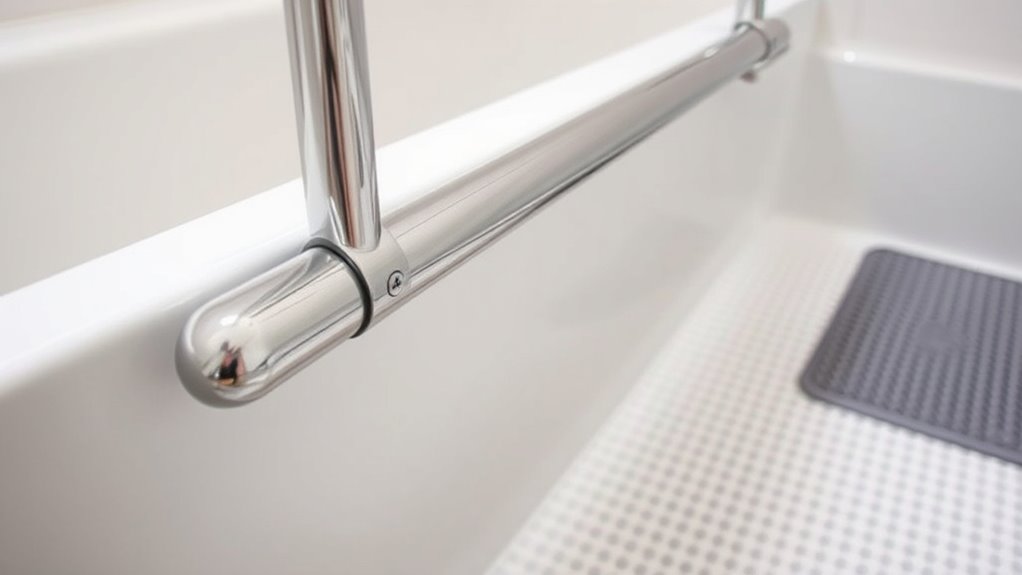
Have you checked that your grab bars and handrails are secure? Loose or unstable bars can cause falls. Start by gently tugging on each one—if it moves, it needs attention. Proper grab bar installation and correct handrail placement are vital for safety. Use the table below as a quick guide:
| Issue | Solution |
|---|---|
| Loose grab bars | Tighten screws or re-install securely |
| Wobbly handrails | Reinforce mounting or replace damaged hardware |
| Incorrect placement | Adjust so they’re within easy reach and grip |
| Rust or corrosion | Clean or replace affected bars |
| Missing bars or handrails | Install where support is needed |
Regularly inspecting your bathroom ensures these safety features remain effective. Additionally, understanding safety regulations can help ensure your bathroom modifications meet local standards.
Test Lighting for Adequate Illumination
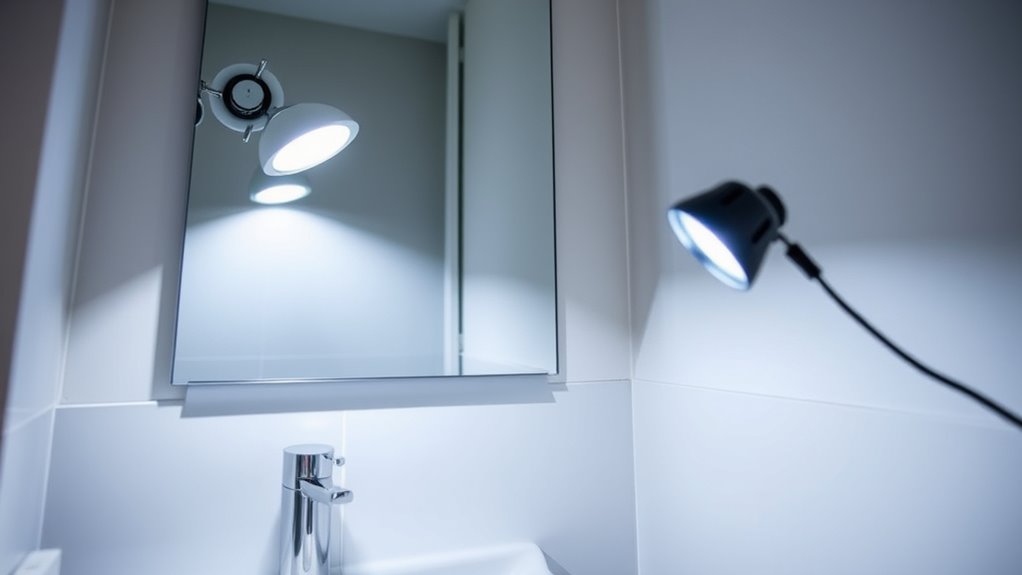
You need to guarantee your bathroom is well-lit to prevent accidents. Use a light meter to check the light levels and see if they meet recommended standards. Proper lighting makes a big difference in safety, so don’t skip this step. Ensuring adequate illumination helps create a safer environment and reduces the risk of slips and falls.
Check Light Levels
Is the bathroom adequately illuminated to guarantee safety? Proper lighting design is essential to prevent accidents, especially near sinks and tubs. Check if the current light levels are sufficient by observing if the space feels bright and clear. If areas seem dim or shadowed, it’s time for bulb replacement or adding more fixtures. Confirm bulbs are functioning correctly and match recommended wattages for your fixtures. Consider upgrading to brighter or energy-efficient bulbs if needed. Proper lighting helps you see clearly, reducing slip risks and ensuring safety for everyone. Regularly evaluating your bathroom’s light levels keeps the space safe and functional. Remember, good lighting isn’t just about brightness; it’s about creating a safe environment for daily use. Additionally, ensuring the lighting setup accommodates adequate illumination enhances overall safety during routine activities.
Use a Light Meter
Using a light meter provides an objective way to measure whether your bathroom’s lighting levels meet safety standards. First, verify your light meter is properly calibrated to get accurate readings. Place the meter at different key points, such as near the sink, shower, and toilet, to assess overall illuminance levels. For safety, the recommended lighting level in bathrooms is typically around 50 to 100 lux, but check local standards. If readings fall below this range, add or adjust light sources. Regularly calibrate your light meter to maintain measurement accuracy. By monitoring illuminance levels, you can identify dim areas that increase fall risks or inadequate lighting that hampers visibility. Ensuring proper lighting levels is crucial for maintaining bathroom safety and preventing accidents. This simple step ensures your bathroom is well-lit and safe for everyone.
Examine Shower and Bathtub for Proper Drainage
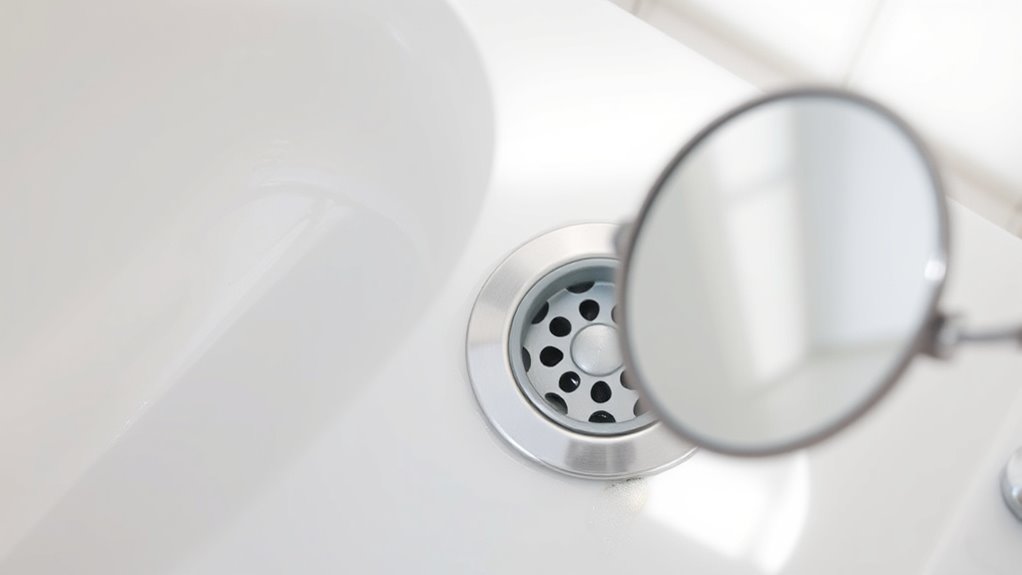
Proper drainage in your shower and bathtub is essential to prevent water from pooling and causing slips or water damage. Start by inspecting the drain for any signs of drainage issues or shower clogging. If water isn’t draining quickly, it could mean there’s a blockage or build-up of debris. Remove the drain cover and check for hair, soap scum, or other obstructions. Use a drain cleaner or a plunger if needed to clear minor clogs. Also, verify the drain grate is properly seated and not damaged. Regular maintenance helps prevent serious drainage problems that could compromise bathroom safety. Addressing these issues promptly keeps water flowing smoothly, reducing slip hazards and water damage risks. Properly functioning drains are key to a safe, hazard-free bathroom environment. Incorporating regular maintenance routines can further ensure your drainage remains clear and safe over time.
Look for Loose or Damaged Flooring and Tiles
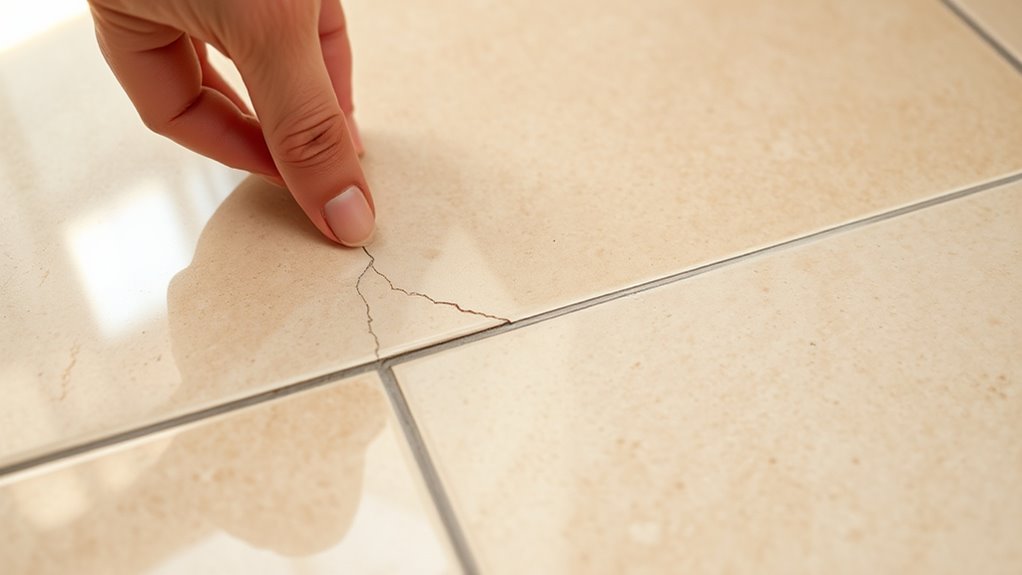
After ensuring your drains are clear and functioning properly, it’s important to check the condition of your bathroom flooring and tiles. Look closely for signs of damage, such as floor tile cracks or loose tiles, which can cause slipping hazards. Also, inspect the grout lines for deterioration, as crumbling grout can lead to water seeping underneath and damaging the subfloor. Using self-watering planters as an analogy, maintaining proper moisture levels and structural integrity helps prevent damage and leaks.
- Feel for loose tiles by gently pressing on them to see if they shift.
- Check for cracked or chipped tiles that might create uneven surfaces.
- Examine grout lines for gaps, discoloration, or crumbling areas.
Addressing these issues promptly helps prevent accidents and water damage, ensuring your bathroom remains a safe space.
Assess Storage for Safe Placement of Toiletries and Cleaning Supplies

Have you checked that your toiletries and cleaning supplies are stored securely and out of reach of children? Proper toiletry organization helps prevent accidental ingestion or spills. Store toiletries in cabinets or high shelves, keeping hazardous items away from little hands. When it comes to cleaning supply safety, avoid storing chemicals under the sink or near the toilet. Use childproof locks on cabinets containing cleaning products, and consider labeling or color-coding containers to distinguish between safe and dangerous items. Regularly check that storage spaces are intact and that lids are tight. Keep all cleaning supplies and toiletries organized and stored safely to minimize risks. Additionally, staying informed about sneaker trends and other safety tips can help create a comprehensive approach to bathroom safety. This simple step considerably reduces potential accidents and creates a safer bathroom environment for everyone.
Verify the Functionality of Faucets and Water Temperature Controls

Start by turning on each faucet to make certain they operate smoothly without leaks. Then, test the water temperature to confirm it adjusts properly and reaches safe levels. Address any issues immediately to prevent accidents and ensure safe use. Additionally, consider inspecting the water pressure to ensure consistent flow, which is important for maintaining environmental considerations during use.
Check Faucet Operation
How can you guarantee your bathroom faucet functions properly and provides safe water temperatures? First, turn on the faucet and observe its operation. Check for faucet leaks, which can cause water waste and damage over time. Ensure the water pressure is steady; inconsistent pressure may signal blockages or worn parts. Test the handle’s movement to confirm smooth operation without sticking. Also, verify that the water flow aligns with expectations—neither too weak nor too forceful. To further ensure safety, consider AI detection methods that can analyze water quality and detect potential contaminants. Remember to:
- Look for leaks around the faucet base and handles
- Assess the water pressure for consistency
- Confirm the handles turn easily without resistance
Addressing these issues promptly ensures your faucet operates safely, efficiently, and without surprises.
Test Water Temperature
After confirming your faucet operates smoothly and doesn’t leak, it’s important to verify that it delivers water at safe and consistent temperatures. Turn on the tap and let the water run for a few seconds. Check if the temperature feels comfortable and steady, not too hot or cold. If the water is too hot, it may indicate a problem with your water heater’s temperature regulation, which could cause scalding hazards. Conversely, if it’s too cold, your water heater might not be functioning properly or needs adjustment. Use a thermometer if needed to precisely measure the water temperature. Ensuring proper temperature regulation helps prevent burns and other safety risks, giving you peace of mind during bathroom use.
Identify and Remove Clutter to Prevent Tripping Hazards
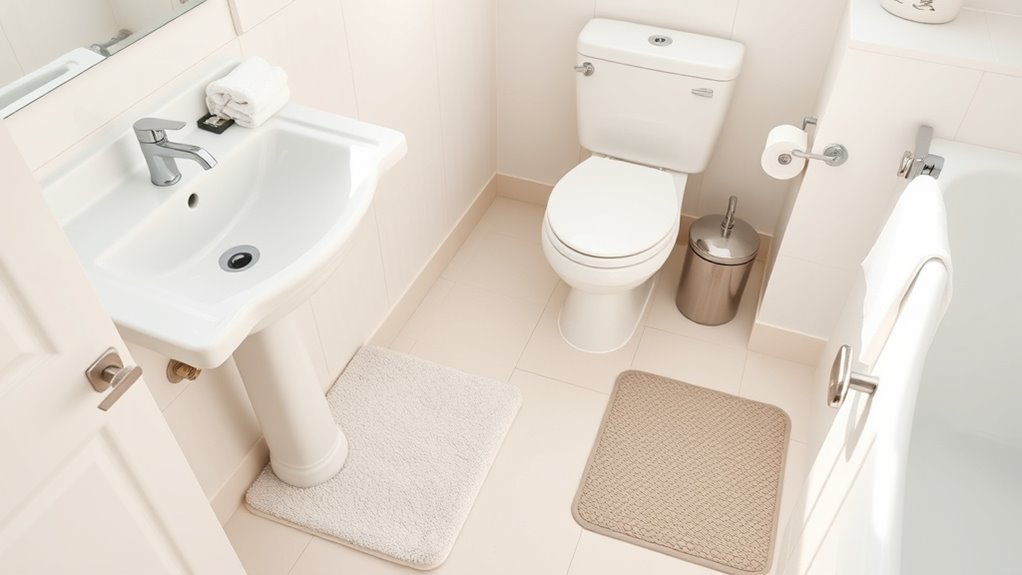
Have you ever tripped over clutter in your bathroom? Clutter removal is essential to prevent tripping hazards. Start by clearing any unnecessary items from the floor, such as towels, bottles, and laundry. Focus on obstacle clearing by organizing essentials into cabinets or shelves. This reduces the risk of falling and makes your bathroom safer.
Remember to:
- Remove loose rugs or secure them firmly
- Keep toiletries stored away when not in use
- Clear pathways of any clutter or debris
Ensure Emergency Alerts and Communication Devices Are Accessible

To make certain you can get help quickly in an emergency, it is vital to keep your emergency alerts and communication devices within easy reach. Accessible alerts ensure you can quickly signal for help if needed. Check that your emergency communication devices, like a waterproof phone or a dedicated alert button, are stored nearby and easy to access from anywhere in the bathroom. Avoid placing devices behind obstacles or in hard-to-reach places. Test your alert system regularly to confirm it functions properly. Clear pathways to these devices also prevent delays during emergencies. By keeping your emergency communication tools accessible, you reduce response time and increase safety, giving you peace of mind that help is always within reach if an incident occurs.
Frequently Asked Questions
How Often Should Bathroom Safety Checks Be Performed?
You should perform bathroom safety checks monthly to keep everything in top condition. Use a safety checklist during each inspection to make certain all elements, like grab bars, lighting, and non-slip mats, are secure and functioning properly. Regular inspections help you catch hazards early and prevent accidents. Make it a routine so your bathroom remains a safe, comfortable space for everyone, especially children and seniors.
What Are Signs of Structural Damage in Bathroom Flooring?
You should look for signs of structural damage in bathroom flooring like soft spots, sagging, or cracks. Keep an eye out for bathroom mold, which indicates excess moisture, often caused by plumbing leaks. If you notice water stains or a musty smell, it’s a sign that leaks might weaken the floor. Address these issues promptly to prevent further damage and guarantee safety.
Are There Recommended Types of Non-Slip Solutions for Showers?
You should consider slip-resistant mats and anti-slip decals for your shower. Slip-resistant mats provide a textured surface that prevents slips, making them ideal for wet areas. Anti-slip decals are easy to apply directly onto tiles or surfaces, offering extra grip without cluttering your shower space. Both options are effective and affordable, helping you stay safe while maintaining comfort. Always choose high-quality products designed specifically for bathroom use.
How Can I Test Grab Bars for Maximum Stability?
You can immediately test grab bars for maximum stability by applying downward pressure during grab bar installation, ensuring it feels firm and secure. To do a stability test, give the bar a gentle but firm tug in different directions—if it doesn’t wobble or shift, you’re good to go. Remember, a secure grab bar is like a safety net; if it wiggles, tighten or re-anchor it before use.
What Emergency Devices Are Best Suited for Bathroom Use?
You should consider installing emergency alarms that are waterproof and easy to reach near the toilet and shower, ensuring quick access in case of falls or emergencies. Non-slip mats are essential for preventing slips on wet surfaces and should be placed strategically around the bathroom. Combining these devices provides an all-encompassing safety solution, giving you peace of mind and quick response options if an accident occurs.
Conclusion
By taking a few simple steps, you can create a more welcoming and secure bathroom environment. Think of these checks as gentle reminders to nurture comfort and confidence in your space. When you address small concerns early, you foster a sense of calm that allows your daily routine to flow smoothly. Remember, a little care goes a long way in turning your bathroom into a safe haven where everyone can feel at ease.









